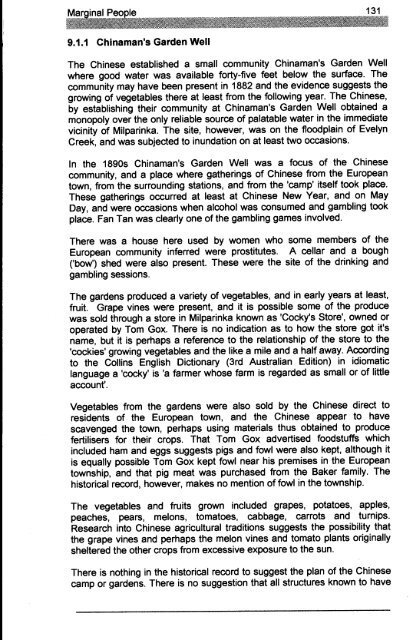Adec Preview Generated PDF File - The Sydney eScholarship ...
Adec Preview Generated PDF File - The Sydney eScholarship ...
Adec Preview Generated PDF File - The Sydney eScholarship ...
You also want an ePaper? Increase the reach of your titles
YUMPU automatically turns print PDFs into web optimized ePapers that Google loves.
9.1.1 Chinaman's Garden Well<br />
<strong>The</strong> Chinese established a small community Chinaman's Garden Well<br />
where good water was available forty-five feet below the surface. <strong>The</strong><br />
community may have been present in 1882 and the evidence suggests the<br />
growing of vegetables there at least from the following year. <strong>The</strong> Chinese,<br />
by establishing their community at Chinaman's Garden Well obtained a<br />
monopoly over the only reliable source of palatable water in the immediate<br />
vicinity of Milparinka. <strong>The</strong> site, however, was on the floodplain of Evelyn<br />
Creek, and was subjected to inundation on at least two occasions.<br />
In the 1890s Chinaman's Garden Well was a focus of the Chinese<br />
community, and a place where gatherings of Chinese from the European<br />
town, from the surrounding stations, and from the 'camp' itself took place.<br />
<strong>The</strong>se gatherings occurred at least at Chinese New Year, and on May<br />
Day, and were occasions when alcohol was consumed and gambling took<br />
place. Fan Tan was clearly one of the gambling games involved.<br />
<strong>The</strong>re was a house here used by women who some members of the<br />
European community inferred were prostitutes. A cellar and a bough<br />
('bow') shed were also present. <strong>The</strong>se were the site of the drinking and<br />
gambling sessions.<br />
<strong>The</strong> gardens produced a variety of vegetables, and in early years at least,<br />
fruit. Grape vines were present, and it is possible some of the produce<br />
was sold through a store in Milparinka known as 'Cocky's Store', owned or<br />
operated by Tom Gox. <strong>The</strong>re is no indication as to how the store got it's<br />
name, but it is perhaps a reference to the relationship of the store to the<br />
'cockies' grOWing vegetables and the like a mile and a half away. According<br />
to the Collins English Dictionary (3rd Australian Edition) in idiomatic<br />
language a 'cocky' is 'a farmer whose farm is regarded as small or of little<br />
account'.<br />
Vegetables from the gardens were also sold by the Chinese direct to<br />
residents of the European town, and the Chinese appear to have<br />
scavenged the town, perhaps using materials thus obtained to produce<br />
fertilisers for their crops. That Tom Gox advertised foodstuffs which<br />
included ham and eggs suggests pigs and fowl were also kept, although it<br />
is equally possible Tom Gox kept fowl near his premises in the European<br />
township, and that pig meat was purchased from the Baker family. <strong>The</strong><br />
historical record, however, makes no mention of fowl in the township.<br />
<strong>The</strong> vegetables and fruits grown included grapes, potatoes, apples,<br />
peaches, pears, melons, tomatoes, cabbage, carrots and turnips.<br />
Research into Chinese agricultural traditions suggests the possibility that<br />
the grape vines and perhaps the melon vines and tomato plants originally<br />
sheltered the other crops from excessive exposure to the sun.<br />
<strong>The</strong>re is nothing in the historical record to suggest the plan of the Chinese<br />
camp or gardens. <strong>The</strong>re is no suggestion that all structures known to have




